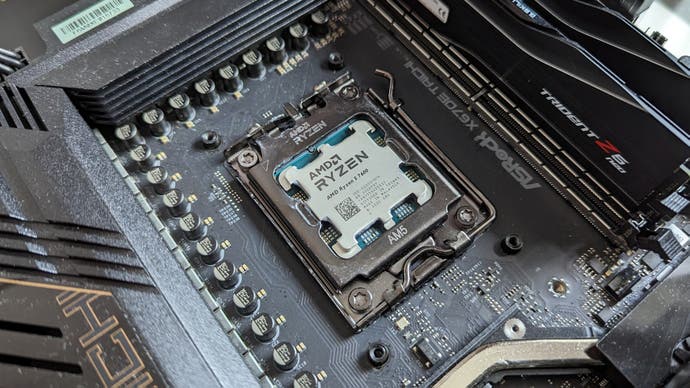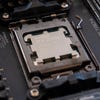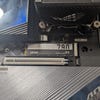AMD Ryzen 5 7600 review: at what cost?
A new cheaper entry-point to the Ryzen 7000 family.
A few days ago, AMD announced a trio of cheaper Ryzen 7000 CPUs at its CES 2023 showcase, featuring more modest 65W TDPs, bundled air coolers and a release date of January 10th. One of these CPUs, the $230/£230 Ryzen 5 7600, has made it to DF HQ where we've put it through our full test suite of the most processor-intensive games. Is this a cheaper entry point to the Ryzen 7000 family with effectively zero compromises, a la the Ryzen 5 5600, or are there still some reasons that you'd consider the more expensive Ryzen 5 7600X?
After all, the Ryzen 7000 'X' processors we've tested so far have demonstrated a larger than average gen-on-gen improvement, as a result of not only the new Zen 4 architecture, but also the switch to the AM5 socket, which can deliver more power - up to 230W. One of the reasons that the Ryzen 5600 is so strong compared to the Ryzen 5600X is that it operates at the same 65W TDP, with the same overclocking tools and Precision Boost 2 algorithm working to maximise performance. Here though, we're dropping from a 105W TDP with the 7600X to a 65W TDP with the 7600 - so it makes sense to imagine a performance differential beyond what the 200MHz drop in boost clocks would suggest.
You can see that in the full spec table for Ryzen 7000 below. As a reminder, each of these Zen 4 designs benefits from a range of improvements over their Zen 3 counterparts, with a quoted 13 percent uptick to instructions-per-clock (IPC) and more internal improvements, like an improved execution engine and a better branch predictor. There's also DDR5 and PCIe 5.0 support, with 5nm CCDs and a 6nm I/O die, alongside the new AM5 socket we mentioned earlier - which unlocks additional power and performance, but also requires a new motherboard and potentially new cooling too.
| CPU design | Boost | Base | L3 cache | TDP | RRP | |
|---|---|---|---|---|---|---|
| Ryzen 9 7950X3D | Zen 4 16C/32T | 5.7GHz | 4.2GHz | 128MB | 170W | TBA |
| Ryzen 9 7950X | Zen 4 16C/32T | 5.7GHz | 4.5GHz | 64MB | 170W | $699/£739 |
| Ryzen 9 7900X3D | Zen 4 12C/24T | 5.6GHz | 4.4GHz | 132MB | 120W | TBA |
| Ryzen 9 7900X | Zen 4 12C/24T | 5.6GHz | 4.7GHz | 64MB | 170W | $549/£579 |
| Ryzen 9 7900 | Zen 4 12C/24T | 5.3GHz | 3.7GHz | 64MB | 65W | $429 |
| Ryzen 7 7800X3D | Zen 4 8C/16T | 5GHz | 4.XGHz | 96MB | 120W | TBA |
| Ryzen 7 7700X | Zen 4 8C/16T | 5.4GHz | 4.5GHz | 32MB | 105W | $399/£419 |
| Ryzen 7 7700 | Zen 4 8C/16T | 5.3GHz | 3.8GHz | 32MB | 65W | $329 |
| Ryzen 5 7600X | Zen 4 6C/12T | 5.3GHz | 4.7GHz | 32MB | 105W | $299/£319 |
| Ryzen 5 7600 | Zen 4 6C/12T | 5.1GHz | 3.8GHz | 32MB | 65W | $229 |
For our testing, we're using the same setup as featured in our 7700X and 7950X review last week. That means an ASRock X670E Taichi motherboard, G.Skill Trident Z5 Neo DDR5-6000 CL30 RAM and Asus' RTX 3090 Strix OC for our graphics card. Cooling is provided by a 240mm Alphacool Eisbaer Aurora AiO, which is happily compatible with the new AM5 socket.
For storage, we're using three PCIe 4.0 NVMe SSDs to hold all of our games - a 4TB Kingston KC3000, a 1TB PNY XLR8 CS3140 and a 1TB Crucial P5 Plus. Our rig was completed with a 1000W Corsair RM1000x power supply.
As before, we're using using a pre-22H2 version of Windows 11, as this seems to offer the best performance for Ryzen 7000 processors. We're also using the latest BIOS for our ASRock X670E Taichi motherboard at the time testing took place, version 1.14.AS06.
For testing other platforms, we used an Asus ROG Crosshair 8 Hero for Ryzen 5000 testing, an Asus ROG Maximus Z590 Hero for 11th-gen Intel testing, an Asus ROG Z690 Maximus Hero for 12th-gen testing, and a Gigabyte Z790 Aorus Master for 13th-gen testing; all of these are high-end boards for their respective platforms. DDR4 motherboards used G.Skill 3600MT/s CL16 memory, the sweetspot for DDR4, while DDR5 motherboards used DDR5-6000 CL30 as noted previously.
Before we get into the gaming benchmarks that make up pages two to five, let's set the scene with some quick content creation benchmarks: a Cinebench R20 3D render and a Handbrake video transcode.
We can immediately see that there's a fair difference between the 105W 7600X and the 65W 7600, with a six to eight percent higher score in Cinebench R20 depending on whether you're looking at the single-core or multi-core result. However, the 7600's performance in both respects is still healthily clear of the last-gen 5600X, with a 17 percent single-core and 25 percent multi-core improvement - so we're still getting a noticeably faster processor here, it's just a half-step behind the 7600X.
Our Handbrake video transcode test results are a similar story, with the 7600's lower TDP and 200MHz lower rated boost clocks contributing to an eight percent performance lead for 7600X over 7600 in terms of both h.264 and h.265 (HEVC) encoding. Again, we're still comfortably ahead of the fastest six-core Ryzen 5000 part here, with performance that's closest to the eight-core Ryzen 7 5800X3D or Ryzen 7 5800X models.
| CB R20 1T | CB R20 MT | HB h.264 | HB HEVC | HEVC Power Use | |
|---|---|---|---|---|---|
| Ryzen 9 7950X | 798 | 14837 | 105.15fps | 45.10fps | 368W |
| Ryzen 9 7900X | 791 | 11324 | 79.38fps | 33.77fps | 288W |
| Ryzen 7 7700X | 768 | 7894 | 56.69fps | 25.95fps | 266W |
| Ryzen 5 7600X | 750 | 6063 | 44.35fps | 20.28fps | 236W |
| Ryzen 5 7600 | 706 | 5632 | 41.09fps | 18.72fps | 196W |
| Ryzen 9 5950X | 637 | 10165 | 70.28fps | 30.14fps | 237W |
| Ryzen 7 5800X3D | 546 | 5746 | 42.71fps | 19.10fps | 221W |
| Ryzen 7 5800X | 596 | 6118 | 44.18fps | 19.50fps | 229W |
| Ryzen 5 5600X | 601 | 4502 | 31.75fps | 14.43fps | 160W |
| Core i9 13900K | 873 | 15570 | 104.67fps | 41.20fps | 473W |
| Core i5 13600K | 767 | 9267 | 62.37fps | 26.44fps | 254W |
| Core i9 12900K | 760 | 10416 | 70.82fps | 29.26fps | 373W |
| Core i7 12700K | 729 | 8683 | 57.64fps | 25.67fps | 318W |
| Core i5 12600K | 716 | 6598 | 44.27fps | 19.99fps | 223W |
| Core i5 12400F | 652 | 4736 | 31.77fps | 14.70fps | 190W |
| Core i9 11900K | 588 | 5902 | 41.01fps | 18.46fps | 321W |
| Core i5 11600K | 541 | 4086 | 29.00fps | 13.12fps | 250W |
Note that power usage, measured at the wall, does drop for the 7600 compared to the 7600X - we saw a 196W peak power draw during the h.265 encode, compared to 236W for the 7600X. That means total system power is around 20 percent lower for the 65W chip, not a bad innings - and presumably we'd see proportionally larger power savings on the 7700 versus the 7700X and the 7900 versus the 7900X.
Now, let's get into the fun stuff - the games. We've tested a range of titles, so pick out your favourites from the links below or just hit that next page button to continue the journey.
AMD Ryzen 5 7600 analysis
- Introduction, test rig and content creation benchmarks [this page]
- Gaming benchmarks: Flight Simulator 2020, Hitman 3
- Gaming benchmarks: Counter-Strike: GO, Metro Exodus EE, Black Ops Cold War
- Gaming benchmarks: Cyberpunk 2077, Far Cry 6, Crysis 3 Remastered
- Gaming benchmarks: Memory bandwidth analysis
- AMD Ryzen 5 7600: the Digital Foundry verdict






